Tips for accidents
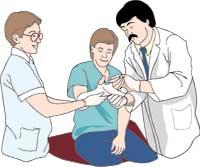
Small cuts
If the incision is small and not deep, it will be cleaned with soap and water, crushing the clean gas to cut off the bleeding. The last step will be to put another sterilized gas on top to prevent the wound from becoming infected. If the cutting object was dirty, or in contact with the soil (and if there have been horses or walkers around), you should see your doctor for a tetanus vaccine.
Animal bites and bites

Clean the wound well with plenty of soap and water and then, while we go to the doctor or hospital, cover it with a gas or leave it outdoors. The doctor will review the wound and decide on the following measures (tetanus vaccination, etc.)
In the event that a snake has bitten, once the wound is cleaned, the injured person will be placed at rest and will immediately move to the hospital, sitting, not lying down.
If the bite or puncture is on the neck or face, or if redness is seen spreading through the body, it is recommended to go to the hospital as soon as possible.
Burns
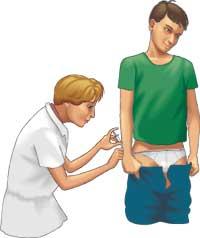
Any kind of old home remedies (e.g. onion, toothpaste, etc.) must be rejected. The most serious causes of burns are those caused by electrocution. Therefore, first we have to disconnect the general grid, and if this is not possible, we will separate the injured person from the source of electricity, but without touching it directly, always using some insulating object (rag, a towel, or even a cane, or a wooden object like a chair). And once this is done, we will immediately transfer the injured person to the hospital.
In sunburn, and before transferring the patient to the care service (if necessary), a calamine and glycerin lotion will be placed, reducing heat and restlessness. How to prepare that lotion? In a bottle are mixed calamine lotion (five tablespoons), water (six tablespoons) and glycerin (two kutxaraditas). It is well powered and ready for use. If we do not have this, put cold water compresses on the head and drink cold but not frozen water.
If the burn is caused by the fire and the clothes are in the fire, the person should not start running: once covered and packed with something thick (a coat, a blanket,...), he will throw himself to the ground and turn on the ground. Before taking it to the hospital, without removing the clothes, it is watered with fresh water from top to bottom and collected in a clean shad.
When the source of the burn is a corrosive liquid, your clothes will be removed and your body part washed with plenty of water washed before you take it to the service.
Twist (e.g. ankle)

The first thing to remove is everything that tightens the joint and as quickly as possible. If you wait too long, it can be very painful to remove a shoe or even a sock.
Apply ice or cold wet rags to the joint to stop inflammation or inflammation and if possible keep the joint up (in the case of the foot it is easy to lift the leg and support it on something) to rest. The joint next to the painful one (e.g. the knee at the ankle or elbow at the wrist) should also be well supported. After a few minutes, if the pain persists, you should see your doctor trying not to move the joint.
Nosebleeds
We will bend the person forward to prevent blood from ingesting and squeeze the nose for about ten minutes as bleeding while breathing through the mouth. At the same time in the nape (or even in the nose itself) cold compresses or gases will be placed.
Poisoning
The Institute of Toxicology (Tel. 91- 562 04 20) and its experts will ask you about the product ingested. It is important, therefore, to be clear what product has caused poisoning. As long as the specialists do not send, the injured person should not take anything (or self-medication) or start causing vomiting. These moments before admission to the hospital should be explained by the origin of the intoxication and the amount of substance ingested, both by the injured and by the environment.
Bleeding with amputation
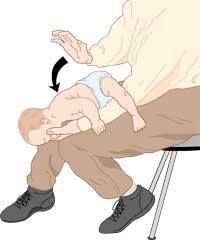
More than in other accidents, the most important thing in these cases is to maintain tranquility from the beginning. While the wound is covered with clean gas or rags, squeeze over the bleeding to prevent further blood loss. Once the amputated part is received it will be stored inside a plastic bag that, well closed, will be deposited on ice cubes until its transfer with the patient to the service.
Pawn
When someone who has swallowed something (or has left the opposite throat) and still cannot breathe, he has to try to cough very hard, to see if he ejects the object that is just annoying. What you never have to do is try to get out what is annoying or hit your back. If it doesn't, or if breathing difficulties continue or increase, all you can do is take it to the hospital and immediately.
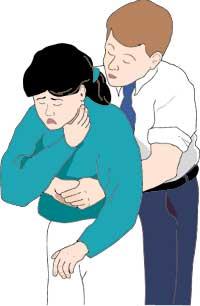
In the case of a small child, we will place it upside down on our knees, with the forearm, touching it as if it were a gabardine or a jacket, and with the edge of the hand we will give a quick blows on his back, between the bones of the mans.If it is a boy of chest, take of the ankles and hang, giving him a gently soft blows.
If the injured person, or the one who cannot breathe is a young person or an adult person instead of being a child, we will place him behind him and surround him with our arms, in the same way as we would to get up in the problem, placing both hands on his navel: once we are so we begin to push automatically, once up and once down, until the object that stags (imhech).
Heart attack
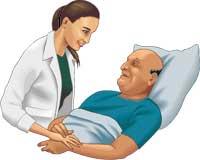
The person suffering from a heart attack will never forget his pain, the main symptom of the disease: the severe and acute pain that appears in the center of the chest progressively rises to the throat, reaching the left arm. This symptom appears suddenly, and normally the patient suffers cold sweat, nausea and dizziness (vegetative reaction). You have to go to the hospital in a hurry, and obviously, those who have had a heart attack (or angina) should not drive.
In short, and although it is easy to say, the important thing is to try to be calm. If the reaction is terror and bustling, you will only get overwhelmed and distressed by the patient. But if you don't know what to do, it's best to ask for help.





